Free Courses Sale ends Soon, Get It Now


Free Courses Sale ends Soon, Get It Now



Disclaimer: Copyright infringement not intended.
Context
India VIX
Impact of VIx
Importance of India VIX Index
How to use India VIX for Trading
RECENT VIX FINDINGS
The rise in VIX marks a sharp rebound from the five-month low of 9.85 recorded on April 23. Such volatility spikes are typical during general elections.
Expert Recommendations
Experts advise against panic but suggest prudent risk management strategies in response to the increased volatility.
Technical Analysis
Nifty Trading Range
Derivative Research at JM Financial, provides insights into Nifty's trading range and potential portfolio adjustments.
Perspective on VIX
Despite the surge in VIX, Bhatt remains cautiously optimistic, citing historical trends and election-related volatility.
|
PRACTICE QUESTION Q. Explain the significance of VIX, commonly known as the Fear Index, in financial markets. Discuss how VIX reflects market sentiment and volatility. Evaluate its implications for investors in managing risk and market stability. |
© 2024 iasgyan. All right reserved